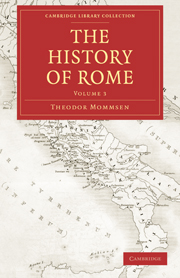Book contents
- Frontmatter
- PREFATORY NOTE
- Contents
- BOOK FOURTH: THE REVOLUTION
- CHAPTER I THE SUBJECT COUNTRIES DOWN TO THE TIMES OF THE GRACCHI
- CHAPTER II THE REFORM MOVEMENT AND TIBERIUS GRACCHUS
- CHAPTER III THE REVOLUTION AND GAIUS GRACCHUS
- CHAPTER IV THE RULE OF THE RESTORATION
- CHAPTER V THE PEOPLES OF THE NORTH
- CHAPTER VI THE ATTEMPT OF MARIUS AT REVOLUTION AND THE ATTEMPT OF DRUSUS AT REFORM
- CHAPTER VII THE REVOLT OF THE ITALIANS AND THE SULPICIAN REVOLUTION
- CHAPTER VIII THE EAST AND KING MITHRADATES
- CHAPTER IX CINNA AND SULLA
- CHAPTER X THE SULLAN CONSTITUTION
- CHAPTER XI THE COMMONWEALTH AND ITS ECONOMY
- CHAPTER XII NATIONALITY, RELIGION, AND EDUCATION
- CHAPTER XIII LITERATURE AND ART
- CORRECTIONS
CHAPTER VII - THE REVOLT OF THE ITALIANS AND THE SULPICIAN REVOLUTION
Published online by Cambridge University Press: 05 October 2010
- Frontmatter
- PREFATORY NOTE
- Contents
- BOOK FOURTH: THE REVOLUTION
- CHAPTER I THE SUBJECT COUNTRIES DOWN TO THE TIMES OF THE GRACCHI
- CHAPTER II THE REFORM MOVEMENT AND TIBERIUS GRACCHUS
- CHAPTER III THE REVOLUTION AND GAIUS GRACCHUS
- CHAPTER IV THE RULE OF THE RESTORATION
- CHAPTER V THE PEOPLES OF THE NORTH
- CHAPTER VI THE ATTEMPT OF MARIUS AT REVOLUTION AND THE ATTEMPT OF DRUSUS AT REFORM
- CHAPTER VII THE REVOLT OF THE ITALIANS AND THE SULPICIAN REVOLUTION
- CHAPTER VIII THE EAST AND KING MITHRADATES
- CHAPTER IX CINNA AND SULLA
- CHAPTER X THE SULLAN CONSTITUTION
- CHAPTER XI THE COMMONWEALTH AND ITS ECONOMY
- CHAPTER XII NATIONALITY, RELIGION, AND EDUCATION
- CHAPTER XIII LITERATURE AND ART
- CORRECTIONS
Summary
Romans and Italians
From the time when the defeat of Pyrrbus had put an end to the last war which the Italians had waged for their independence—or, in other words, for nearly two hundred years—the Roman primacy had now subsisted in Italy, without having been once shaken in its foundations even under circumstances of the utmost peril. Vainly had the heroic family of the Barcides, vainly had the successors of Alexander the Great and of the Achæmenidæ, endeavoured to rouse the Italian nation to contend with the too powerful capital; it had obsequiously appeared in the fields of battle on the Guadalquivir and on the Mejerdah, at the pass of Tempe and at Mount Sipylus, and with the best blood of its youth had helped its masters to achieve the subjugation of three continents. Its own position meanwhile had changed, but had deteriorated rather than improved. In a material point of view, no doubt, it had in general not much ground to complain. Though the small and intermediate landholders throughout Italy suffered in consequence of the injudicious Roman corn-laws, the larger landlords and still more the mercantile and capitalist class were flourishing, for the Italians enjoyed, as respected the financial profits of the provinces, substantially the same protection and the same privileges as Roman burgesses, and thus shared to a great extent in the material advantages of the political ascendancy of the Romans.
- Type
- Chapter
- Information
- The History of Rome , pp. 226 - 271Publisher: Cambridge University PressPrint publication year: 2010First published in: 1863

